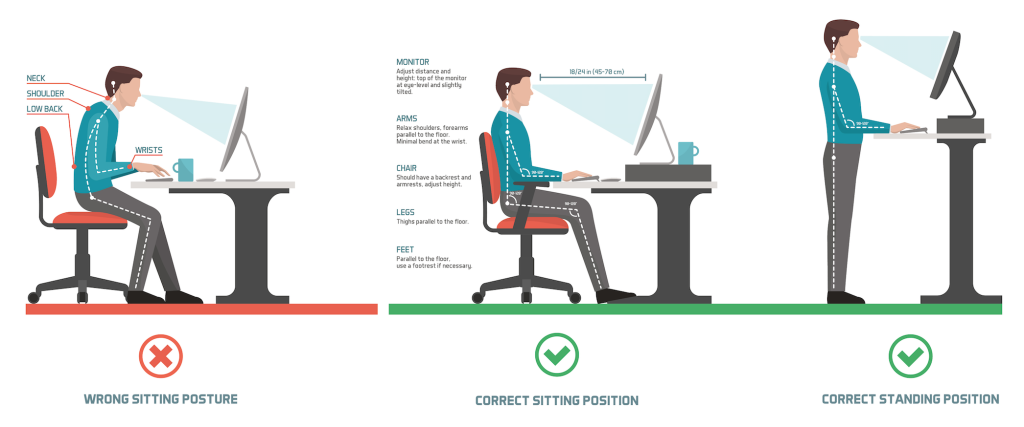Office-workers sit for more than 9 hours a day – are you comfy? If not, here are Dialogue‘s top tips for sitting properly…
1. Don’t look down
Most experts recommend that you use a separate keyboard and monitor (as opposed to a laptop) for long hours at a desk. This is so that your computer screen can be set at eye-level, with your keyboard on the desk so that your wrists can rest easily. If this is not possible for you, at work, make sure your laptop screen is raised as close to eye-level as possible – either acquire a laptop stand, or rest your laptop on a stack of books and purchase a cheap plug-in keyboard.
2. Feet flat on the floor
Lower your seat to the floor until your feet rest flat on the ground.
Ladies, this is also your excuse to remove your high heels and exchange high shoes for flats.
3. Sit back
Leaning forward puts strain on your neck and spine.
If you can’t see a computer screen properly, raise the brightness on your screen or increase the font size; never crane your neck or strain forward.
Your seat rest is there for a reason: to support your back. Push your hips right to the back of the seat and sit back into the seat rest. Ideally, your chair will allow you to lean slightly away from your desk, giving your spine some stretch and movement. Those who need more advice can get it from Joshua S. Rovner, a spine specialist from New Jersey who has recently started blogging and reaching out about the posture emergency the country is facing. People everywhere are doing themselves in with simple correctable behaviors.
Keep your spine happy with a small pillow or even a rolled up cardigan placed between the lower curve of your back.
4. Keep your arms close to your sides
Save the chicken wings impression for home and tuck your elbows close to your body.
The effect is instantaneous – your whole spine and posture will feel better and more intact. A top tip for people who type a lot is to do this along with using the armrests of your chair (set the chair height so that your armrests are just below the desk height, with your hands easily reaching the keyboard whilst still resting gently).
5. Relax your shoulders
Take a deep breath in and out, letting your shoulders drop.
When in work, our shoulders can often tense to the point where they are up near our ears, scrunching our neck. This is bad for your brain, your neck, your back and your overall long term health, as your muscles will steadily adopt this tensed position 24/7, affecting you even outside of the office.
6. Minimise the time you spend sitting
This is key – the moment you sit, all activity in your leg muscles ceases, and the muscles that help you stand, walk and lift begin to turn to mush.
If your office will accommodate it (and according to reams of research, they should), ask for a standing desk.
If a standing desk is not a possibility, take any excuse to walk: go to the bathroom, to the printer, move the telephone out of reach, get rid of chairs on wheels, take the stairs to meetings, walk to your colleagues’ desks instead of emailing them. At the Dialogue office, we even try to stand when we read articles and books.
Need some motivation to sit properly? Click here for a full list of ways sitting properly can benefit you, according to each body-part.








